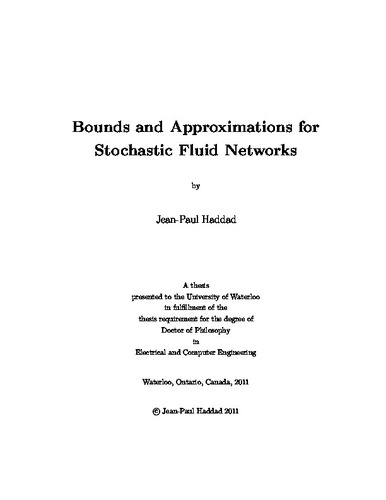UWSpace will be migrating to a new version of its software from July 29th to August 1st. UWSpace will be offline for all UW community members during this time.
Bounds and Approximations for Stochastic Fluid Networks
| dc.contributor.author | Haddad, Jean-Paul | |
| dc.date.accessioned | 2011-08-12 19:51:21 (GMT) | |
| dc.date.available | 2011-08-12 19:51:21 (GMT) | |
| dc.date.issued | 2011-08-12T19:51:21Z | |
| dc.date.submitted | 2011 | |
| dc.identifier.uri | http://hdl.handle.net/10012/6082 | |
| dc.description.abstract | The success of modern networked systems has led to an increased reliance and greater demand of their services. To ensure that the next generation of networks meet these demands, it is critical that the behaviour and performance of these networks can be reliably predicted prior to deployment. Analytical modeling is an important step in the design phase to achieve both a qualitative and quantitative understanding of the system. This thesis contributes towards understanding the behaviour of such systems by providing new results for two fluid network models: The stochastic fluid network model and the flow level model. The stochastic fluid network model is a simple but powerful modeling paradigm. Unfortunately, except for simple cases, the steady state distribution which is vital for many performance calculations, can not be computed analytically. A common technique to alleviate this problem is to use the so-called Heavy Traffic Approximation (HTA) to obtain a tractable approximation of the workload process, for which the steady state distribution can be computed. Though this begs the question: Does the steady-state distribution from the HTA correspond to the steady-state distribution of the original network model? It is shown that the answer to this question is yes. Additionally, new results for this model concerning the sample-path properties of the workload are obtained. File transfers compose much of the traffic of the current Internet. They typically use the transmission control protocol (TCP) and adapt their transmission rate to the available bandwidth. When congestion occurs, users experience delays, packet losses and low transfer rates. Thus it is essential to use congestion control algorithms that minimize the probability of occurrence of such congestion periods. Flow level models hide the complex underlying packet-level mechanisms and simply represent congestion control algorithms as bandwidth sharing policies between flows. Balanced Fairness is a key bandwidth sharing policy that is efficient, tractable and insensitive. Unlike the stochastic fluid network model, an analytical formula for the steady-state distribution is known. Unfortunately, performance calculations for realistic systems are extremely time consuming. Efficient and tight approximations for performance calculations involving congestion are obtained. | en |
| dc.language.iso | en | en |
| dc.publisher | University of Waterloo | en |
| dc.subject | Stochastic Fluid Networks | en |
| dc.subject | Balanced Fairness | en |
| dc.title | Bounds and Approximations for Stochastic Fluid Networks | en |
| dc.type | Doctoral Thesis | en |
| dc.pending | false | en |
| dc.subject.program | Electrical and Computer Engineering | en |
| uws-etd.degree.department | Electrical and Computer Engineering | en |
| uws-etd.degree | Doctor of Philosophy | en |
| uws.typeOfResource | Text | en |
| uws.peerReviewStatus | Unreviewed | en |
| uws.scholarLevel | Graduate | en |

